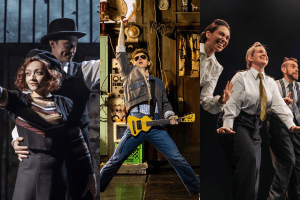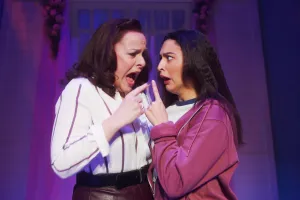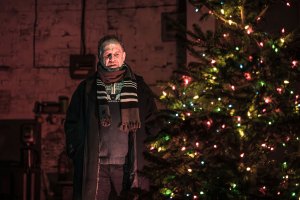Andrew Holland on coming Up Out o’ the Sea
Tell us about your connexion to Eastern Angles and the National Theatre
Studio
The director Sam Potter worked on a piece of mine called The Place To Be at the National Studio. Sam had previously worked with Ivan Cutting (artistic director of Eastern Angles) and talked to him about my work. We met up and, through Ivan’s good services, some money was found to work on a new play – The Cloud Sensation – at UEA (the University of East Anglia).
While stuck on a bus on the way to UEA, I was thinking where to go next, and the germ of Up Out o’ the Sea came to me. I had two characters in my head that day – a young woman visiting a small coastal town, and an old fisherman living there. I thought of the man as someone who kept popping up – wearing different hats as it were. Wherever she went, he was there. I wanted to explore the woman’s reason for going to the village, and something she unearthed there.
Reading around I came across accounts of the region’s fishing industry and also the role of fishermen in saving their own. In today’s world “volunteering” has become synonymous with “unprofessional” and looked down on. Years ago it had a nobility that no amount of Government insistence on a Big Society is going to bring back. There’s the need – quite understandable when you’re a tax payer – to measure, track and give targets.
But there’s also an emotional side to this kind of community engagement that no amount of added-value tracking can accommodate. I wanted the woman to bring something of that modern, outsider’s view into the village, and to see what happened when the past was brought back to the surface.
You now live in Suffolk and have written another play which involves the
county. How did Ever Your Loving Son come about?
Some years ago I presented Ian Kelly’s A Soldier’s Tale”, a compilation of poems and letters from the First World War. I performed it at the Sandham Memorial Chapel – a small but amazing building whose interior was painted in the 1920s by Stanley Spencer. His scenes of military life are a disturbing mix of the horrors of war with the often mundane life of the soldiers at its heart.
When later I presented the same piece at my local church to raise money for the British Legion, it struck me that there would be stories here.
I made a request through our village newsletter, and was lucky enough to be given access to a box full of letters written from the front, by Lorimer and Clavering Fison and (from a hospital in France) by their sister Madeline. Some were to their mother, others to an Uncle Herbertwho lived in Ipswich.
One of the most interesting things about the letters was the contrast, not only between the two brothers, but also in how they wrote for their audience. A letter to mother would minimize risk, while one to their uncle would allow more candour. Being country boys, the letters also talked of flora and fauna, of hearing birds singing amongst the guns. I also wanted to include poems, but rather than using the familiar ones by Sassoon, Brooke, Owen, A.P. Herbert and others, decided to use mainly poems written by women – some of them set to music.
You are also an audio describer. How did that come about, and what does
it involve?
I was working as education director at Cambridge Theatre Company, when I heard about training being offered in audio description at the National Theatre. I’d heard of it, but in England it was still quite a new idea. Simply stated, audio description is a way of making a play accessible to someone who is blind or partially sighted. The action of a play is described live to visually impaired people who are sitting in the theatre wearing a headset.
They hear the actors speaking their lines and, in the gaps between, the describer will tell them what’s happening visually. This is incredibly important in some scenes – where it is only through visual clues that an audience will know what’s going on.
Describers work with DVDs of the plays they are describing so that they are very familiar with what needs to be said and how long they have to say it. In some ways it’s like the opposite of a cricket commentary on the radio, where there’s a lot of time and often not much to say.
In description there may be two seconds in which to mention that X is now pregnant, Y has a black eye and Z is dead – or whatever. After doing some research for the Arts Council, I helped set up the audio description company VocalEyes in 1998. The original brief was to describe touring theatre, but work has expanded to include West End shows, musicals, ballet, circus, street theatre, as well as into other cultural areas such as museums, galleries and heritage sites.
How did you begin to write plays, and why?
I started writing when I was in a youth theatre. We walked from Guildford to Canterbury performing an adaptation I’d done of The Canterbury Tales in pubs and on village greens along the way. I loved the robustness of the stories and also how you had to win audiences -– you couldn’t just expect them to watch.
Since then I’ve written other adaptations, including Oscar Wilde’s The Canterville Ghost, The Pied Piper of Hamelin and a version of the Ananse stories. This last was written for all 80 children of the local primary school including my then six year-old daughter – to whom of course I gave the best line. It’s now being done by Lewisham Youth Theatre.












